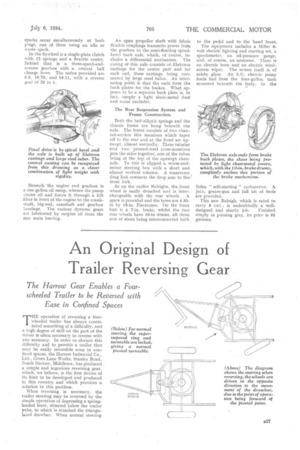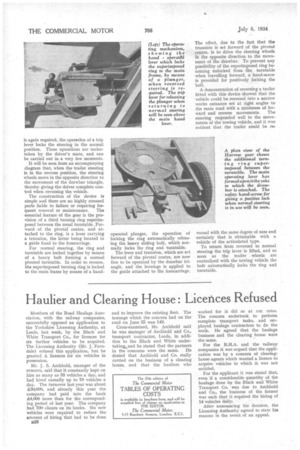An Original Design of Trailer Reversing Gear
Page 45

Page 46

If you've noticed an error in this article please click here to report it so we can fix it.
The Harrow Gear Enables a Fourwheeled Trailer to be Reversed with Ease in Confined Spaces THE operation of reversing a fourwheeled trailer has always constituted something of a difficulty, and a high degree of skill on the part of the driver is often necessary to reverse with any accuracy. In order to obviate this difficulty and to provide a trailer that may be easily reversible even in confined spaces, the Harrow Industrial Co., Ltd., Green Lane Works, Stanley Road, South Harrow, Middlesex, has produced a simple and ingenious reversing gear, which, we believe, is the first device of its kind to be developed and produced in this country and which provides a solution to this problem.
When reversing is necessary, the trailer steering may be reversed by the simple operation of depressing a springloaded lever, situated below the trailer yoke, to which is attached the triangulated drawbar. When normal steering
is again required, the operation of a trip lever locks the steering in the normal position. These operations are undertaken by the driver's mate, and can be carried out in a very few moments.
It will be seen from an accompanying diagram that, when the trailer steering Is in the reverse position, the steering wheels move in the opposite direction to the movement of the drawbar triangle, thereby giving the driver complete control when reversing the vehicle.
The construction of the device is simple and there are no highly stressed parts liable to failure or requiring frequent renewal or maintenance. The essential feature of the gear is the provision of a third turning ring superimposed between the usual turntable. Forward of the pivotal centre, and attached to the ring, is a lever carrying a trunnion, the latter being located in a guide fixed to the forecarriage.
For normal steering, the ring and turntable are locked together by means of a heavy bolt forming a normal pivoted turntable. In order to reverse, the superimposed turning ring is locked to the main frame by means of a hand
operated plunger, the operation of locking the ring automatically releasing the heavy sliding bolt, which normally locks the ring and turntable.
The lever and trunnion, which are set forward of the pivotal centre, are now free to be operated by the drawbar triangle, and the leverage is applied to the guide attached to the forecarriage. The effect, due to the fact that the trunnion is set forward of the pivotal centre, is to drive the steering wheels in the opposite direction to the movement of the drawbar. To prevent any possibility of the superimposed ring becoming unlocked from the turntable when travelling forward, a band-screw is provided for positively locking the bolt.
A demonstration of reversing a trailer fitted with this device showed that the vehicle could be reversed into a narrow works entrance set at right angles to the main road with a minimum of forward and reverse movements. The steering responded well to the movements of the towing vehicle, and it was evident that the trailer could be re
versed with the same degree of ease and certainty that is obtainable with a vehicle of the articulated type.
To return from reversed to normal steering the trip lever is lifted, and so soon as the trailer wheels are centralized with the towing vehicle the bolt automatically locks the ring and turntable.




































































































